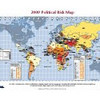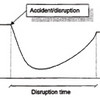 I had the pleasure of meeting M.A.P. Taylor at the 3rd International Symposium on Transport Network Vulnerability (INSTR 2007). His research has many bearings towards my own research in that it is concerned with transport network vulnerability in sparse rural and remote networks. In his 2006 paper, Application of Accessibility Based Methods for Vulnerability Analysis of Strategic Road Networks, Taylor and his fellow contributors develop a methodology for assessing the socio-economic impacts of transport network degradation by using the change in accessibility prior to and after degradation of the road network as a measure for the importance or criticality of the road link.
I had the pleasure of meeting M.A.P. Taylor at the 3rd International Symposium on Transport Network Vulnerability (INSTR 2007). His research has many bearings towards my own research in that it is concerned with transport network vulnerability in sparse rural and remote networks. In his 2006 paper, Application of Accessibility Based Methods for Vulnerability Analysis of Strategic Road Networks, Taylor and his fellow contributors develop a methodology for assessing the socio-economic impacts of transport network degradation by using the change in accessibility prior to and after degradation of the road network as a measure for the importance or criticality of the road link.
Why is network vulnerability important?
The starting point for this paper is the question of how to define and find critical locations in a transport network. What makes one location more vulnerable than the other, and how can one compare different impacts? Clearly, the loss of transportation network in one location will have different consequences from the loss or degradation of transportation in a different location, so how can these be measured on the same scale? This is where the accessibility index comes into play, since the standard approaches to transport network reliability (as opposed to vulnerability) often obscure problems in large-scale sparse and non-congested regional or national road networks.
What is transport network vulnerability?
While transport network reliability focuses on connectivity and probability, vulnerability is more closely related to network weaknesses and the impact of failure. The paper defines network vulnerability as follows.
a network node is vulnerable if loss or degradation of a small number of links diminishes the accessibility of the node
a network link is critical if loss or degradation of the links diminishes the accessibility of the network or of particular nodes
What I find noteworthy is that vulnerability is connected to the node, whereas criticality is connected to the link. It possible to extend these definitions, as in saying
Accessibility Index
The paper discusses both the renown Hansen accessibility index and the Australian Accessibility/Remoteness Index (ARIA). In setting of sparse network ARIA is better suited than Hansen, which works very well in comparing major and well-separated population centers, whereas ARIA is used to estimate the level of government and private sector services available to residents in remote areas. Changes in generalized travel cost to these centers as a result of network degradation is then used as a measure of changes in accessibility.
Results
The paper convincingly displays the results of several network scans after degrading individual links and nodes, clearly showing the changes in accessibility.
[Figure to be inserted here]
Further research
What the paper does not show, but leaves open for further research, among other suggestions, is the effect of multiple link failures. In addition, further refinement of the methods used is needed, among which interpretation of the results for the individual communities. Increase in generalized travel cost is only one measure, but it does not fully comprise overall the socio-economic impact.
Conclusion
The paper proves that accessibility measurements can provide valuable insights into which parts of the road network that are more important or critical than others. Although it does not provide a full socio-economic evaluation, it goes a long way in pin-pointing locations with vulnerable or critical access gateways.
Reference
Taylor, M., Sekhar, S., & D’Este, G. (2006). Application of Accessibility Based Methods for Vulnerability Analysis of Strategic Road Networks Networks and Spatial Economics, 6 (3-4), 267-291 DOI: 10.1007/s11067-006-9284-9
Author links
- unisa.edu.au: M.A.P. Taylor
- researchgate.net: Somenahalli V C Sekhar
- qut.edu.au: Glen M D’Este
Related
- husdal.com: Transport Network Vulnerability Metrics












